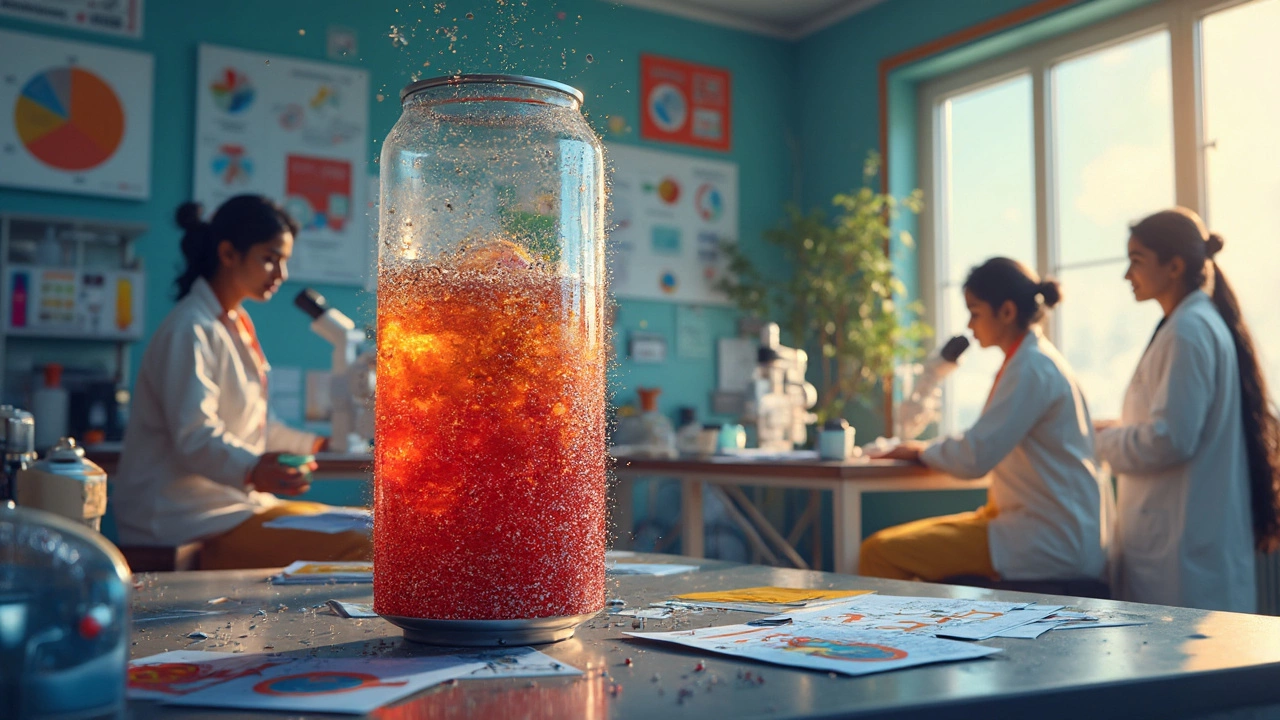What Sodas Have Nanoparticles? New Facts You Need to Know
 May, 13 2025
May, 13 2025
If you've ever wondered what’s really inside your can of cola, you’re not alone. Nanoparticles—tiny particles you can’t see with the naked eye—have started making their way into the drinks aisle, and yes, that includes sodas. These ultra-small bits can change the look, feel, and shelf life of sodas. Food companies use them for a bunch of reasons, mostly to make sodas more appealing or last longer.
The funny thing is, most people never notice them. You won’t see “contains nanoparticles” in bold letters on a regular soda can. So how do you know if your favorite soda is using this tech? The real trick is in the ingredient list, and it’s not as complicated as it sounds.
- What Are Nanoparticles and Why Are They in Soda?
- Common Sodas with Nanoparticles: What’s on the Shelf?
- How to Identify Nanoparticles on Ingredient Labels
- Expert Opinions and Recent Studies
- Smart Tips for Soda Drinkers
What Are Nanoparticles and Why Are They in Soda?
Nanoparticles are super tiny particles—so small that you’d need a microscope to even spot them. We’re talking about stuff that’s a billionth of a meter in size. Sounds wild, right? In food and drinks, especially soda, these particles are sometimes used to change what you see, taste, or feel when you sip a drink.
So, why do companies put nanoparticles in soda? It comes down to a few main reasons:
- Color and cloudiness: Stuff like titanium dioxide nanoparticles makes sodas look brighter or more cloudy (think lemon-lime drinks that look milky white).
- Texture: Some nanoparticles help keep drinks smooth by preventing ingredients from clumping.
- Preservation: They can help extend shelf life—less spoilage, longer fridge time.
- Flavor delivery: Certain nanoparticles tweak how flavor hits your tongue, sometimes making sweeteners more effective.
The tricky thing? Companies don’t always make it obvious. For example, titanium dioxide and silicon dioxide are names you might see in the ingredients—they’re both used for color and to prevent lumps. The nano versions work the same way but are much smaller, making them more effective in some cases.
Just to give you an idea, here’s a table showing some typical nanoparticles and what they actually do in sodas:
| Nanoparticle | Why It's Added | Example Ingredient Label Name |
|---|---|---|
| Titanium Dioxide (TiO2) | Color/Cloudiness | Titanium Dioxide |
| Silicon Dioxide (SiO2) | Anti-caking, Stabilizer | Silicon Dioxide |
| Silver Nanoparticles | Preservation (rare in sodas) | Usually not labeled, mostly in some specialty drinks |
If you dig into recent research, the use of nanoparticles in the food industry isn’t rare. According to a study from the University of Arizona in 2022, over 800 processed foods have been found to contain engineered nanoparticles—and that includes some popular sodas.
Bottom line: these particles have roles to play, but you probably wouldn’t notice unless you know what to look for. That’s what makes awareness so important for anyone who actually cares what they're drinking.
Common Sodas with Nanoparticles: What’s on the Shelf?
This part usually surprises people: most big soda brands don’t clearly say they use nanoparticles, but some types of soda do contain ingredients that are often made in nanoparticle form. The main one you’ll see is titanium dioxide (sometimes listed as E171), which gives drinks that cloudy look in stuff like some citrus sodas or “cloudy lemonade.” Another common player is silicon dioxide (sometimes called “anticaking agent”), used to keep powdered drinks free-flowing, and it can show up in fountain-style soda mixes.
A study published in 2023 by Arizona State University found particles in the nano-range in some off-the-shelf lemonade sodas and citrus sodas, especially the ones with that artificial, cloudy look. But none of the major brands—think Coca-Cola, Pepsi, Sprite—openly claim to use engineered nanoparticles in their canned or bottled drinks in the U.S. or UK. The European Union actually banned titanium dioxide as a food additive in 2022 because of lingering safety questions, so sodas sold there have mostly dropped it from their recipes.
Where should you pay closer attention? Look at:
- Imported lemon-lime sodas that still have E171/titanium dioxide in markets outside the EU
- Store-branded “cloudy” or opaque sodas (think supermarket lemon or lime sodas)
- Some energy drinks or sodas that use “nano” ingredients for added color or shelf life (rare, but possible in newer brands trying to stand out)
You probably won’t see “nanoparticles” right on the label, so keeping an eye out for ingredients like titanium dioxide or silicon dioxide is the best move. Energy drinks and sodas from smaller, experimental brands are more likely to experiment with nanotech, while the big names mostly play it safe and avoid controversy—at least for now.

How to Identify Nanoparticles on Ingredient Labels
Trying to figure out if your soda has nanoparticles? It’s not as obvious as you’d hope. Food manufacturers rarely write “nanoparticles” on labels. Instead, you see technical names for additives or colorants—some of which are made with nanoparticles, even though the packaging says nothing about it.
One big thing to look for is the ingredient titanium dioxide, sometimes listed as E171. This is used to make drinks look whiter or milkier. In a bunch of cases, it’s made with nano-sized particles. Silver (E174), silicon dioxide (E551), and even certain iron oxides (E172) show up in colorings too, and some studies have found them in nano form in soft drinks and candies.
“If a drink lists titanium dioxide or silicon dioxide, there’s a chance it contains nanoparticles, because manufacturers favor the nano form for its smooth texture and even color,” says Dr. Priya Ramesh, a food technology specialist at Mumbai University.
Now, here’s a tip: in the EU, new rules require foods containing engineered nanomaterials to say so clearly. But in India and many other places, there’s no such rule—so companies aren’t actually breaking any laws by keeping it vague.
If you want to play detective, here’s how you can spot possible nanoparticles in sodas:
- Scan the label for: titanium dioxide (E171), silicon dioxide (E551), silver (E174), and iron oxides (E172).
- Watch out for the words "nano" next to an additive name—rare, but it happens.
- Clear sodas usually don’t need these additives, but colorful or creamy-looking sodas sometimes do use them.
- Imported brands, especially those from the EU, might actually say “nano” or “nano form.”
Here’s a quick look at where these ingredients might pop up:
| Additive | Common Use | Found In |
|---|---|---|
| Titanium dioxide (E171) | Color, whitening | Creamy sodas, lemon-lime sodas |
| Silicon dioxide (E551) | Anti-caking, clarity | Powdered drink mixes |
| Silver (E174) | Decoration, shine | Pearlescent sodas, energy drinks |
| Iron oxides (E172) | Red-yellow color | Fruit-flavored sodas |
Bottom line? The best way to avoid nanoparticles for now is to stick with simple ingredient sodas and be a label hawk. You’re not likely to see “contains nanoparticles,” but if you spot those additives, there’s a decent shot the nano kind is in the mix.
Expert Opinions and Recent Studies
There’s a lot of chatter about nanoparticles in soda, but what do the real experts say? Food scientists and toxicologists have been debating the safety and long-term effects of these tiny additives, especially since they can end up in everyday soda brands.
The main nanoparticles found in sodas and other drinks are usually forms of titanium dioxide (used for color whitening) and silicon dioxide (used as an anti-caking agent). In 2023, the European Food Safety Authority (EFSA) released a detailed review pointing out that while silicon dioxide seems safe at current levels, they couldn’t totally rule out some risks, especially with long-term, heavy consumption. Titanium dioxide grabbed headlines a year earlier, when the EU banned its use as a food additive due to possible links with DNA damage—though US regulators still allow it in limited amounts.
Here’s what’s wild: a study from the American Chemical Society in late 2022 found trace levels of nanoparticles in around 12% of the soft drinks tested in the US. Those were mainly energy drinks, lemon-lime sodas, and some clear sodas, but they didn’t pop up everywhere.
| Source/Study | Year | Main Finding |
|---|---|---|
| European Food Safety Authority (EFSA) | 2023 | Silicon dioxide mostly safe; lingering uncertainty on long-term effects |
| EU Regulatory Update | 2022 | Titanium dioxide banned as a food additive |
| American Chemical Society Study | 2022 | Nanoparticles found in about 12% of tested sodas |
US food agencies, including the FDA, still list these ingredients as “generally recognized as safe” for now. But experts keep calling for more research. The big reason: nanoparticles don’t always behave like their larger cousins. They might get absorbed by the body more easily, and nobody really knows what happens when you drink them every day for years.
If you check scientific journals or news from late 2024, the message is pretty clear. We don’t have smoking-gun evidence that drinking sodas with nanoparticles will harm you right away, but there aren’t tons of long-term human studies either. So, some scientists recommend limiting sodas with these additives, especially if you’re already drinking lots of processed foods or sugary drinks.

Smart Tips for Soda Drinkers
When it comes to grabbing a soda, it pays to know what you’re actually drinking, especially now that nanoparticles might be in the mix. Most big soda brands won’t spell it out plainly, but there are easy ways to stay one step ahead.
- Check for E-numbers or unfamiliar additives: Titanium dioxide (E171) and silicon dioxide (E551) are often used for color and texture. If you spot these on the label, there’s a chance nanoparticles are in there—even if it’s not stated.
- Go for simpler ingredient lists: Some smaller brands or “natural” sodas steer clear of high-tech additives, so their labels are shorter and easy to read. Less is usually better here.
- Keep up with recent news: Ingredient rules can change fast. Some countries already ban certain nanoparticles, but others don’t. A quick online search for updates pays off.
- Don’t fall for fancy terms: Buzzwords like “nano-enhanced” or “improved mouthfeel” don’t have clear definitions, so don’t assume they mean something healthy or safe.
Want to see what’s actually in some common sodas?
| Soda Brand | Possible Nano Additive | Common Use |
|---|---|---|
| Citrus-flavored sodas | Silicon Dioxide (E551) | Prevents caking, keeps liquid clear |
| Cola drinks | Titanium Dioxide (E171) | Whitens or brightens certain sodas |
| Diet sodas | Nano-silica | Improves consistency |
As Dr. Steve Keely from the European Food Safety Authority put it,
“Consumers should be aware that additives like E171 might include nanoparticles, which are currently being reevaluated for their safety.”
If you’re not sure about something you find on an ingredient list, it’s worth a quick search or even dropping the brand an email. Companies that care about their customers usually answer straight up.
You don’t need to panic—but a little label reading and curiosity goes a long way if you want to know exactly what you’re sipping on.